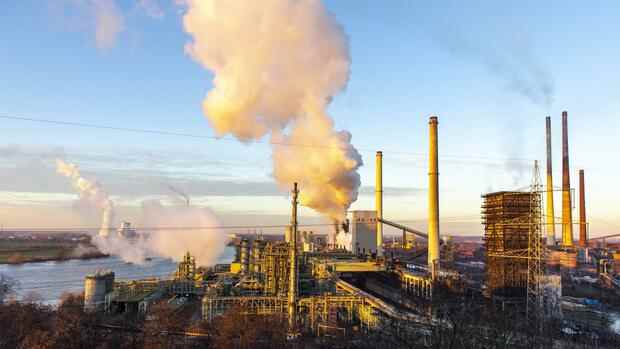Munich, Dusseldorf The steel industry is pushing for investment security on the way to green steel. “The political framework for investments worth billions has yet to be created,” said Hans Jürgen Kerkhoff, President of the Steel Industry Association, at the Handelsblatt annual conference “Zukunft Stahl”.
The industry has an “effective lever for CO2 reduction,” said Kerkhoff. But time is pressing. “We need more speed.” What is needed is “state support for investments in low-CO2 processes, which are not yet economical”.
Geert Van Poelvoorde, CEO of ArcelorMittal Europe, also warned: “In 2022 it will be decided how big or how small the European steel industry will be in the future.” The previous plans in Brussels were not sufficient to ensure the future viability of the industry.
Green steel, made with hydrogen instead of carbon, is currently the hot topic in the industry. Because the steel industry accounts for 30 percent of industrial emissions in Germany. According to experts, if Germany wants to achieve its climate goals, around a third of primary steel production will have to be converted to direct reduction technology with hydrogen by 2030, and all blast furnaces will have to be replaced by 2045.
Top jobs of the day
Find the best jobs now and
be notified by email.
Bernhard Osburg, CEO of Thyssen-Krupp Steel Europe emphasized: “The steel industry can now make history.” The industry could be the “nucleus of a decarbonized European economy”. However, the steel industry faces tough international competition. “Every month that goes by hurts competitiveness.”
The problem: The green steel is more expensive than conventionally produced steel. According to a new study by BCG, which is available to the Handelsblatt, the cost per tonne of steel would increase by around 70 percent by 2030 if you switched to the hydrogen process. This corresponds to an increase of around 260 euros per ton.
Higher prices for green steel
According to the calculations, the price of a mid-range car using only green steel would increase by almost 250 euros if the increased costs were passed on directly. With a washing machine it would be less than twelve euros.
Accenture’s experts estimate that the car costs between 500 and 1,000 euros and the washing machine costs around 30 euros. The companies would have to find out how they can achieve these additional prices through marketing, said Gerd-Michael Huesken, Managing Director of Accenture.
The steel manufacturers could also develop new products in cooperation with customers, for example in the automotive industry, said Götz Erhardt from Accenture. The industry has already done a lot in recent years. “Sustainability and climate protection offer opportunities to further differentiate oneself.”
Many manufacturers have announced correspondingly large goals. Thyssen-Krupp’s steel production should be climate-neutral by 2045. However, the necessary investments for the industry are in the double-digit billion range in Germany alone.
The companies are therefore waiting for the government to give the go-ahead for large-scale support. There are corresponding signals from the federal government. The coalition partners had agreed “that what is needed will also be financed,” Economics Minister Robert Habeck said at the Handelsblatt energy summit in January.
But Brussels is also in demand, according to Kerkhoff. “Germany can only go the way in Europe and with Europe.” The planned revision of European emissions trading threatened additional costs of up to 16 billion euros by 2030 for the German steel industry.
The president of the steel trade association expects additional costs in the billions when converting to hydrogen.
(Photo: Uta Wagner)
Osburg von Thyssen-Krupp also appealed to Brussels. The planned reduction in free certificates cannot be managed if billions have to be invested in the transformation at the same time. “Steel is an absolutely systemically relevant industry and is therefore not suitable for experiments.”
Industry wants to keep steel production in Germany
The Saarland Secretary of State for Economic Affairs, Jürgen Barke, said that support was also needed for the operating costs. Production must be prevented from being relocated to other locations. It’s not just about fighting climate change. The corona pandemic has shown how important it is not to be dependent on third parties for the raw materials.
Meanwhile, companies are pushing the issue. Thyssen-Krupp gave the go-ahead for a real laboratory at the Duisburg location this week. There are plans to build a pipeline and expand the use of hydrogen to cover the entire blast furnace 9.
Thyssen-Krupp was one of the pioneers in the industry. In 2019, the group was the first company in the world to blow hydrogen into a running blast furnace in Duisburg. The hydrogen replaces coal dust as an additional reducing agent.
Georgsmarienhütte focused on the production of low-CO2 steel in electric arc furnaces early on. According to CEO Alexander Becker, the biggest lever for pushing the numbers further is the expansion of renewables. “We really hope that the new federal government will do everything in its power to achieve its goals, courageously and vigorously.”
Last year, the production of crude steel in Germany rose again for the first time in three years – by twelve percent to a good 40 million tons. However, the manufacturers are still below the level of 2017 (a good 43 million tons).
More: Steel industry insists on quick commitments from politicians
